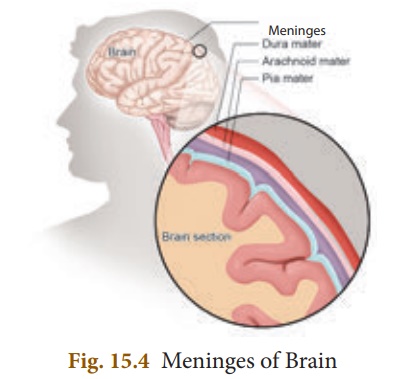Central Nervous System - Human Nervous System | 10th Science : Chapter 15 : Nervous System
Chapter: 10th Science : Chapter 15 : Nervous System
Human Nervous System
Human
Nervous System
The complexity of
nervous system can be observed during the course of evolution. We the human
beings differ from other animals in our ability to think and take actions,
which is due to the well developed nervous system. Human nervous system is
differentiated into central nervous system (CNS), peripheral nervous system
(PNS) and autonomic nervous system (ANS).
The CNS acts as centre
for information processing and control. It consists of the brain and the spinal
cord. The PNS is made up of the nerves which connect the brain and spinal cord
to all parts of the body. The ANS is formed of sympathetic and parasympathetic
nerves.![]()
![]()
Central Nervous System
The brain and the spinal
cord being delicate vital structures are well protected in bony cavities of the
skull and the vertebral column respectively. CNS is formed of two types of matter
such as white matter or grey matter with respect to the presence or absence of
myelin sheath which we have discussed earlier.

The brain is the
controlling centre of all the body activities. It is covered by three
connective tissue membrane or meninges :
(i) Duramater (dura: tough; mater: membrane)is
the outermost thick fibrous membrane
(ii) Arachnoid membrane (arachnoid: spider) is the middle,
thin vascular membrane providing web like cushion
(iii) Piamater (Pia: soft or tender) is the innermost,
thin delicate membrane richly supplied with blood.
Meningeal membranes
protect the brain from mechanical injury.
A human brain is formed
of three main parts: (a) forebrain (b) midbrain and (c) hindbrain.

Forebrain: The forebrain is formed
of cerebrum and diencephalon. The latter consists of dorsal thalamus
and ventral hypothalamus.
Cerebrum
It is the largest
portion forming nearly two-third of the brain. The cerebrum is longitudinally
divided into two halves as right and left cerebral hemispheres by
a deep cleft called median cleft. Two cerebral hemispheres are
interconnected by thick band of nerve fibres called corpus callosum. The
outer portion of each cerebral hemisphere is formed of grey matter and
is called cerebral cortex. The inner or deeper part is formed of white
matter and is called cerebral medulla. The cortex is extremely
folded forming elevations called gyri with depressions between
them termed as sulci that increase its surface area.
Each cerebral hemisphere
is divisble into a frontal lobe, a parietal lobe, a temporal lobe and an
occipital lobe. These lobes are also known as cerebral lobes and are
associated with specific functions. Any damage in specific lobe inturn affects
its function.![]()
![]()
The cerebrum is
responsible for the thinking, intelligence, consciousness, memory, imagination,
reasoning and willpower.
Thalamus
Thalamus present in
cerebral medulla is a major conducting centre for sensory and motor signalling.
It acts as a relay centre.
Hypothalamus
It lies at the base of
the thalamus. It controls involuntary functions like hunger, thirst, sleep,
sweating, sexual desire, anger, fear, water balance, blood pressure etc. It
acts as a thermoregulatory (temperature control) center of the
body. It controls the secretion of hormones from anterior pituitary
gland and is an important link between nervous system and endocrine system.
Midbrain
It is located between
thalamus and hind brain. The dorsal portion of the mid brain consists of four
rounded bodies called corpora quadrigemina that control visual
and auditory (hearing) reflexes.
Hindbrain
It is formed of three
parts cerebellum, pons and medulla oblongata.
Cerebellum
It is second largest
part of the brain formed of two large sized hemispheres and middle vermis. It
coordinates voluntary movements and also maintains body balance.
Pons
‘Pons’ a latin
word meaning bridge. It is a bridge of nerve fibre that connects the lobes of
cerebellum. It relay signals between the cerebellum, spinal cord, midbrain and
cerebrum. It controls respiration and sleep cycle.
Medulla Oblongata
Medulla oblongata is the
posterior most part of the brain that connects spinal cord and various parts of
brain. It has cardiac centres, respiratory centres, vasomotor centres to
control heart beat, respiration and contractions of blood vessels respectively.
It also regulates vomiting and salivation.

Spinal Cord
Spinal cord is a
cylindrical structure lying in the neural canal of the vertebral column. It is
also covered by meninges. It extends from the lower end of medulla oblongata to
the first lumbar vertebra. The posterior most region of spinal cord tapers into
a thin fibrous thread like structure called filum terminale.
Internally, the spinal
cord contains a cerebrospinal fluid filled cavity known as the central canal.
The grey matter of spinal cord is ‘H’ shaped. The upper end of letter
‘H” forms posterior horns and lower end forms anterior horns. A
bundle of fibres pass into the posterior horn forming dorsal or afferent
root. Fibres pass outward from the anterior horn forming ventral or
efferent root. These two roots joins to form spinal nerves.
The white matter is external and have bundle of nerve tracts. Spinal cord conducts
sensory and motor impulses to and from the brain. It controls reflex actions of
the body.


Related Topics